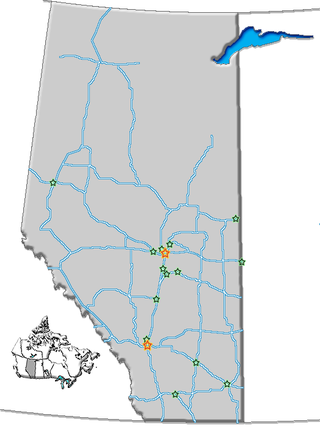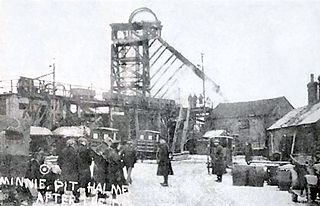
Drumheller is a town on the Red Deer River in the badlands of east-central Alberta, Canada. It is located 110 kilometres (68 mi) northeast of Calgary and 97 kilometres (60 mi) south of Stettler. The Drumheller portion of the Red Deer River valley, often referred to as Dinosaur Valley, has an approximate width of 2 kilometres (1.2 mi) and an approximate length of 28 kilometres (17 mi).
The Westray Mine was a Canadian coal mine in Plymouth, Nova Scotia. Westray was owned and operated by Curragh Resources Incorporated, which obtained both provincial and federal government money to open the mine, and supply the local electric power utility with coal.
A mining accident is an accident that occurs during the process of mining minerals or metals. Thousands of miners die from mining accidents each year, especially from underground coal mining, although accidents also occur in hard rock mining. Coal mining is considered much more hazardous than hard rock mining due to flat-lying rock strata, generally incompetent rock, the presence of methane gas, and coal dust. Most of the deaths these days occur in developing countries, and rural parts of developed countries where safety measures are not practiced as fully. A mining disaster is an incident where there are five or more fatalities.

The Royal Tyrrell Museum of Palaeontology is a palaeontology museum and research facility in Drumheller, Alberta, Canada. The museum was named in honour of Joseph Burr Tyrrell, and is situated within a 12,500-square-metre-building (135,000 sq ft) designed by BCW Architects at Midland Provincial Park.
The History of coal mining goes back thousands of years, with early mines documented in ancient China, the Roman Empire and other early historical economies. It became important in the Industrial Revolution of the 19th and 20th centuries, when it was primarily used to power steam engines, heat buildings and generate electricity. Coal mining continues as an important economic activity today, but has begun to decline due to the strong contribution coal plays in global warming and environmental issues, which result in decreasing demand and in some geographies, peak coal.

Dinosaur Provincial Park is a UNESCO World Heritage Site situated 220 kilometres east of Calgary, Alberta, Canada; or 48 kilometres (30 mi) northeast of Brooks.
Glace Bay is a community in the eastern part of the Cape Breton Regional Municipality in Nova Scotia, Canada. It forms part of the general area referred to as Industrial Cape Breton.

Joseph Burr Tyrrell, FRSC was a Canadian geologist, cartographer, mining consultant and historian. He discovered dinosaur (Albertosaurus sarcophagus) bones in Alberta's Badlands and coal around Drumheller in 1884. Canada's Royal Tyrrell Museum of Palaeontology in Alberta was named in his honour.

Alberta has been a tourist destination since the early days of the 20th Century, with attractions including national parks, National Historic Sites of Canada, urban arts and cultural facilities, outdoor locales for skiing, hiking and camping, shopping locales such as West Edmonton Mall, outdoor festivals, professional athletic events, international sporting competitions such as the Commonwealth Games and Olympic Winter Games, as well as more eclectic attractions.
The Castle Gate mine disaster occurred on March 8, 1924, in a coal mine near the town of Castle Gate, Utah, located approximately 90 miles southeast of Salt Lake City. All of the 171 men working in the mine were killed in the series of three violent explosions. One worker, the leader of the rescue crew, died from carbon monoxide inhalation while attempting to reach the victims shortly after the explosion.

Canmore Museum and Geoscience Centre (CMAGS) is the public name used by the Centennial Museum Society of Canmore. The Society was incorporated in 1984 under The Societies Act of the Province of Alberta. The society is also a registered charity. In June 2004, the museum moved from its original location to a new purpose built space in the Canmore Civic Centre. Spanning generations, cultures and social classes, the museum presents over 120 years worth of local history.

Provincial historic sites of Alberta are museums and historic sites run by the Government of Alberta.

The Atlas Coal Mine National Historic Site is an inactive coal mine in Alberta, Canada that operated from 1936 to 1979. Located in East Coulee near Drumheller, it is considered to be Canada's most complete historic coal mine and is home to the country's last standing wooden coal tipple, and the largest still standing in North America. It was designated an Alberta Provincial Historic Resource in 1989 and a National Historic Site of Canada in 2002.
The Dinosaur Trail is a circular tourist route in the province of Alberta, Canada, located in the Canadian badlands paralleling the Red Deer River on both sides, from Drumheller to the Bleriot Ferry. It is divided in two segments, with the South Dinosaur Trail following the south side of the river and uses portions of Highway 575 and Highway 837, while North Dinosaur Trail follows the north side of the river and is the entirety of Highway 838. The north and south segments of Dinosaur Trail are connected by the Highway 9 / Highway 56 concurrency within Drumheller.

The Minnie Pit disaster was a coal mining accident that took place on 12 January 1918 in Halmer End, Staffordshire, in which 155 men and boys died. The disaster, which was caused by an explosion due to firedamp, is the worst ever recorded in the North Staffordshire Coalfield. An official investigation never established what caused the ignition of flammable gases in the pit.

Midlandvale is a community within the Town of Drumheller, Alberta, Canada. It was previously a hamlet within the former Municipal District of Badlands No. 7 prior to being annexed by Drumheller in 1972. Now referred to as Midland by the Town of Drumheller, the community is located within the Red Deer River valley on North Dinosaur Trail, approximately 3 km (1.9 mi) west of Drumheller's main townsite.
Mining is an important industry in Pakistan. Pakistan has deposits of several minerals including coal, copper, gold, chromite, mineral salt, bauxite and several other minerals. There are also a variety of precious and semi-precious minerals that are also mined. These include peridot, aquamarine, topaz, ruby, emerald, rare-earth minerals bastnaesite and xenotime, sphene, tourmaline, and many varieties and types of quartz.
Jane Colwell-Danis is the first formally-trained female vertebrate paleontologist employed in Canada and was known for finding numerous rare fossils in the southern Canadian prairies.

In February 2016, a series of explosions caused the deaths of 36 people, including 31 miners and five rescue workers, at the Severnaya coal mine 10 kilometres north of the city of Vorkuta, Komi Republic, Russia. The explosions were believed to be caused by ignition of leaking methane gas. It is the second deadliest mining disaster of the 2010s behind the Soma mine disaster, and fourth deadliest of the 21st century thus far.

On 10 December 1910, an explosion occurred underground in the West Canadian Collieries No. 1 Mine in the Crowsnest Pass community of Bellevue, Alberta. The explosion pushed all of the air out of the mine and filled it with afterdamp, a deadly gas that is a mixture of Carbon dioxide and Carbon monoxide, killing 30 of the 42 workers present at the time, as well as one rescue worker. The explosion was the first mining disaster in Alberta's history, and led to several changes in coal mining in the Crowsnest Pass. The event was soon overshadowed by the nearby Hillcrest mine disaster four years later, which killed 189 and is Canada's worst mining disaster to date.















